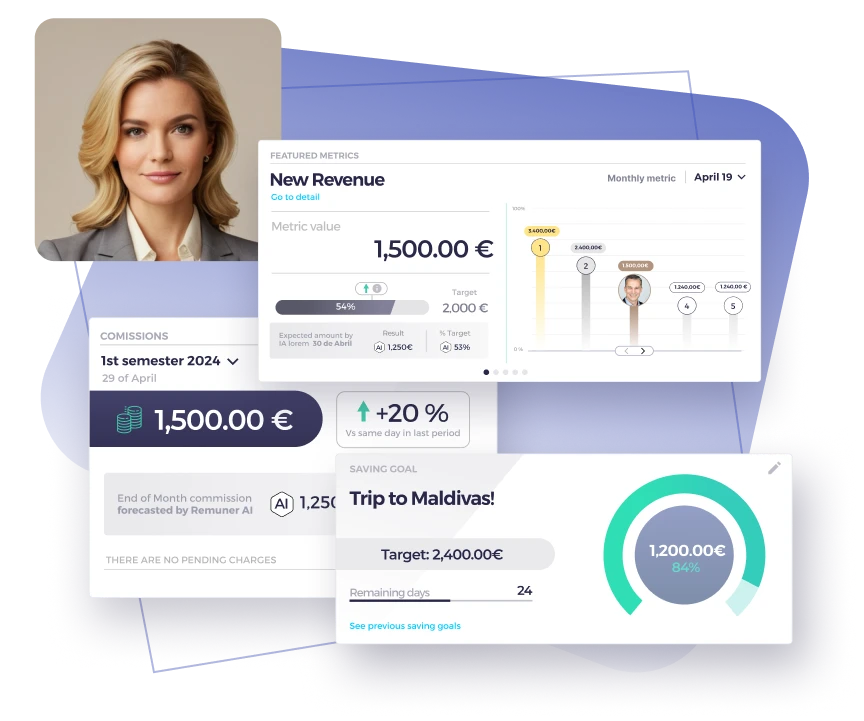Table of contents
In the world of SaaS metrics, few indicators matter more than net revenue retention (NRR). While metrics like monthly recurring revenue (MRR) or gross revenue retention (GRR) tell part of the story, NRR provides a full view of how much revenue you’re retaining—and expanding—within your existing customer base.
In this article, we’ll explore what net revenue retention means, how to calculate it, why it’s critical for revenue growth, and how aligning it with sales incentives and compensation plans (with the help of tools like Remuner) can maximize results.
What is net revenue retention (NRR)?
Net revenue retention is a metric that measures how much recurring revenue you retain from existing customers over a specific period—after accounting for upgrades, downgrades, and customer churn. Unlike gross revenue retention (GRR), which excludes expansion revenue, NRR reflects the true impact of account growth and contraction. That makes it one of the most important metrics for any SaaS company focused on long-term growth.
Net revenue retention formula
Here’s how to calculate net revenue retention:
NRR = (Starting MRR + Expansion – Contractions – Churn) ÷ Starting MRR × 100
Example:
Let’s say:
- Starting MRR from existing customers = $100,000
- Expansion = $20,000
- Contractions (downgrades) = $5,000
- Churn (lost customers) = $10,000
Your NRR would be:
(100,000 + 20,000 – 5,000 – 10,000) ÷ 100,000 × 100 = 105%
That means your company is growing revenue from current customers—even after accounting for churn.
Why net revenue retention matters
High NRR is a sign of healthy customer retention, strong product-market fit, and well-aligned customer experience efforts. It means you’re not just holding onto customers—you’re increasing their lifetime value.
Benefits of a high NRR:
- More efficient growth with lower acquisition costs
- Stronger customer loyalty and product adoption
- Higher valuation multiples for SaaS businesses
- Better alignment between customer success, sales, and product teams
According to industry benchmarks:
- A “good net revenue retention” rate for SaaS companies is typically over 100%
- Top-performing companies often hit 120–140%+
Increasing net revenue retention isn’t just a financial metric—it’s a growth engine. Consider research done by Frederick Reichheld of Bain & Company (the inventor of the Net Promoter Score), which shows that increasing customer retention rates by just 5% can boost profits by 25% to 95%. This demonstrates the direct link between customer loyalty and long-term revenue growth.
What affects your net revenue retention rate
Several factors can push your net revenue retention rate up or down:
Factors that increase NRR:
- Strong customer onboarding and adoption
- Frequent upsells or usage-based pricing
- Value-driven customer success programs
- Tight alignment between CSMs and AMs
Factors that reduce NRR:
- Poor onboarding and support
- Inactive product users
- Unclear renewal terms
- Lack of incentives for expansion revenue
💡 Tools like Remuner allow you to tie variable compensation to expansion KPIs, ensuring that account managers and customer success teams are incentivized to grow revenue from existing customers.
Net revenue retention vs. gross revenue retention
| Metric | Includes Expansion? | Focus | Benchmark |
| GRR | No | Retention only | 85–90% |
| NRR | Yes | Retention + Growth | 100–120%+ |
While GRR helps you spot churn issues, NRR shows whether your business is truly compounding value within its existing customer base.
Examples of how companies improve NRR
1. Upsell-based sales incentives
A B2B SaaS company tied account manager commissions to expansion revenue instead of just renewals. This shift boosted NRR from 96% to 112% in three quarters.
With Remuner, they automated commission tracking based on expansion activity, making payouts simple and performance-focused.
2. Customer success-led renewals
A PLG startup empowered its CSM team to own renewals and adoption. By linking bonuses to net revenue retention, reps became more proactive in engagement.
Remuner made it easy to design and track this comp model without spreadsheets or delays.
3. Product usage scoring
Another SaaS org implemented usage-based scoring to forecast churn and expansion likelihood. When usage increased, account teams received sales performance bonuses tied to usage milestones.
Compensation was adjusted through Remuner’s dynamic comp modeling tools, which helped track goals in real time.
Aligning compensation with NRR
Traditional comp plans often overlook NRR, especially for CSMs and post-sale teams. To improve NRR, you need to pay people to grow it.
Here’s how:
Good incentive structure for NRR:
- Account Managers: Commission tied to upsells and expansions
- Customer Success Managers: Bonuses based on NRR growth, product adoption, or churn reduction
- Sales leaders: Quota attainment tied to retained MRR
🎯 With Remuner, you can create performance-based comp plans that directly reward NRR gains—automating payout tracking and removing friction from variable comp management.
How to improve net revenue retention
Here are tactical ways to boost your NRR over time:
- Improve customer onboarding
Make sure customers activate key product features quickly. - Create usage milestones
Drive adoption through lifecycle campaigns or in-app nudges. - Invest in customer success
Build a CS team that is proactive, data-informed, and aligned with revenue goals. - Offer expansion paths
Introduce add-ons, tier upgrades, or usage-based billing. - Align incentives to NRR
If no one is compensated for growth within accounts, don’t expect it to happen.
How Remuner helps increase net revenue retention
Whether you’re a CSM leader, RevOps manager, or CRO, Remuner helps you boost NRR by making performance-driven incentives scalable and measurable.
With Remuner, you can:
- Tie comp to expansion revenue and retention
- Build NRR-based variable plans for AMs and CSMs
- Track performance with real-time dashboards
- Automate payouts with zero spreadsheet drama
- Forecast the revenue impact of comp changes before rollout
If you’re serious about driving more value from your existing customer base, aligning incentives with NRR is your best lever—and Remuner gives you the toolset to make it happen.
FAQs about Net revenue retention
What is net revenue retention?
Net revenue retention (NRR) measures how much recurring revenue you retain from existing customers, including upgrades and downgrades, excluding new sales.
How do you calculate net revenue retention?
Use the formula:
(Starting MRR + Expansion – Contractions – Churn) ÷ Starting MRR × 100
Why is NRR important for SaaS companies?
It reflects the real growth potential of your customer base. A high NRR means you’re expanding existing accounts and reducing churn rate.
What is a good NRR rate?
For SaaS, anything above 100% is considered healthy. Top-tier companies hit 120% or more.
How is NRR different from gross revenue retention?
GRR excludes expansion revenue, focusing only on how much base revenue remains. NRR includes upsells and is a better measure of overall growth.
Can NRR be improved through compensation plans?
Yes. Incentivizing account growth, renewals, and adoption through tools like Remuner is a proven way to boost NRR.
What roles should be rewarded based on NRR?
CSMs, AMs, and RevOps teams should all have part of their compensation tied to NRR and other important metrics.





